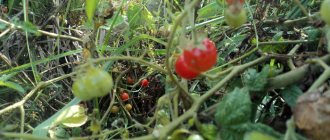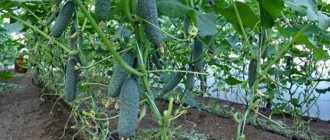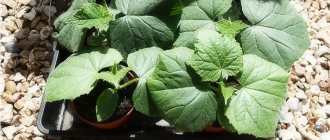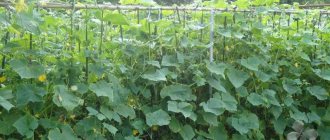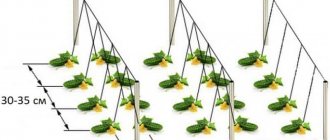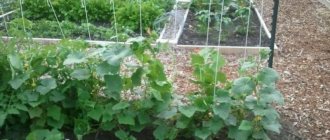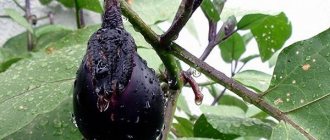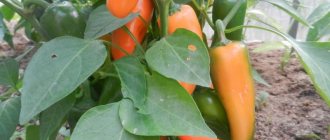Many gardeners believe that when it comes to cucumbers in the country, you only need to sow the seeds, and then water the seedlings and fight weeds during the summer, without in any way affecting the growth and branching of the shoot. However, this is a deep misconception. The formation of cucumbers in open ground must be done.
This agricultural technique is of great importance, since the vines are given the desired direction of growth and all the nutrition received by the plant is spent on producing a crop of cucumbers. In this article we will look at how to form traditional varieties, modern varieties and hybrids grown in summer cottages.
Why do you need to form cucumbers in a greenhouse?
Cucumbers are much more comfortable in a greenhouse than in open ground. Here, plants are provided with a stable microclimate, in which natural disasters are not scary. In good conditions, the lashes grow quickly. If cucumbers are not shaped, they will be difficult to care for, but this is not the main reason for the need for pruning and pinching. Forming cucumbers allows you to:
- reduce the risk of pest damage;
- slow down the spread of infections inside the greenhouse;
- save space;
- improve ventilation and lighting of bushes;
- use fertilizers rationally.
This procedure is especially necessary for late varieties. Such plants are prone to the formation of barren flowers. The formation of plants will help reduce the percentage of male flowers.
Benefits of a garter
- A cucumber plant that grows upward saves space in the greenhouse for planting other low-growing crops.
- Receiving a large amount of sunlight, many shoots are formed on the bush, which contributes to the appearance of new ovaries.
- The location will facilitate the process of spraying the bushes evenly, as well as harvesting
- Easy treatment for disease prevention
- The tied stems do not drag or get tangled on the ground, as this can contribute to rotting and affect the development and taste of the fruit.
How to form cucumbers in a greenhouse into one stem: step-by-step diagram
The formation of bushes with one stem has a positive effect on the size of the fruit - cucumbers become large, since the plants do not waste their energy on the vital activity of the side shoots. This method is suitable for parthenocarpics and hybrids. With this formation scheme, more plants can be planted in the greenhouse. Not only the weight but also the number of fruits increases, and the fruiting period is extended. From one square meter of area you can get up to 15 kg of greens.
Formation scheme:
- the bush is fixed to the crossbar after 5-6 leaves appear;
- remove all stepsons, flowers and ovaries to a height of 50 cm;
- after this, leave 2 ovaries next to every third leaf;
- Closer to the top, 3 ovaries are left near every fourth leaf.
This way an even bush is formed. Removing shoots, flowers and ovaries at the bottom of the shoot is called "blinding". The freed lower tier eliminates contact of the plant with the soil, reduces the risk of diseases, and improves ventilation.
With free growth
When planting a low-growing variety of cucumbers, there is no need to tie up the plant, but the formation should not be neglected.
Interesting on the topic:
Sea buckthorn sisters: gumi and shepherdia
Mar 5, 2022
I carefully care for hydrangea at the end of summer - I ensure...
Mar 5, 2022
During active fruiting, it is recommended to change the position of the shoots; the leaves should be turned in the other direction. Thanks to this, the plant will be green for a long time and give a bountiful harvest.
How to properly tie cucumbers
Gartering cucumbers is a rather labor-intensive process. However, this technique helps:
- better preserve the harvest and make it easier to harvest;
- prevent tangling of lashes;
- accelerate the ripening of side shoots that bear fruit;
- make it easier to care for the crop (you can easily pinch it and direct the mustache in the right direction);
- regulate the number of male and female flowers;
- avoid spoilage of fruits and damage by insects.
To tie cucumbers, you need to install a trellis in the greenhouse in advance. For its manufacture and subsequent garter you will need:
- wooden or metal poles 2 m high;
- wire or twine;
- plastic mesh;
- hooks for fixing the mesh;
- wooden pegs;
- strips of cotton fabric 2 cm wide and 20-25 cm long;
- pliers, hammer, nails.
Do not use thin wire or fishing line for work - these materials can easily damage fragile shoots. The bushes are tied up at about a month of age, when the height of the plant reaches 30-35 cm. The timing of tying should not be violated; over time, the elastic stems become harder and can be damaged during fixation.
You can tie cucumbers in different ways:
- Horizontal garter is carried out along the soil level. Most often used in low greenhouses. Metal or wooden supports are dug in on both sides of the bed, and strong twine or wire is pulled between them. The lower tier should be at a height of 25-30 cm, then the steps are placed in increments of 35-40 cm. Instead of wire, you can attach a trellis made of plastic mesh to the posts. You need to secure it so that the bottom edge is at a height of 30 cm from the ground. When the plant grows to the lower tier of the trellis or the edge of the mesh, the main stem is loosely fixed with fabric strips. Subsequently, the side shoots are fixed on adjacent steps.
- Vertical tying is carried out in high greenhouses (more than 2 m in height). The top bar of the structure should be located under the ceiling, and the other should be located below. For convenience, it can be dug into the ground. Stretches of rope are constructed between the slats. In this case, each bush will have its own vertical support, which it will wrap around. Not very tall varieties of cucumbers can be tied to pegs or metal rods driven into the ground.
- The mixed method is used for circular planting of cucumbers. The design consists of 10 metal rods that form a cone between themselves. A mesh is fixed on top of them. Subsequently, the tendrils of cucumber plants are passed into the mesh cells. The shoots themselves begin to weave around the constructed pyramid. The cone is installed before sowing the seeds so as not to damage the young plantings.
It is convenient to use plastic pipes as a vertical support; for reliability, they are dug deep into the ground.
On a note! To prevent the ends of the pegs from rotting in the soil, before immersion they are soaked in a strong saline solution or soaked in gasoline.
Terms of formation
The formation of a cucumber begins as soon as it begins to actively grow. After 5 full leaves appear on the plant, it is fixed on a support. Soon the bush begins to branch. The formation method is selected individually in each specific case.
You cannot be late with deadlines. For example, if the stepsons are not removed in time, a significant portion of the harvest may be missed. The first stepsoning is done when the plant has risen in height by 20 cm. Subsequently, the stepsons are removed as they grow, until the end of July.
Pinching and trimming
Pinching and pruning should be done in the morning, according to certain rules - this will help maintain the health of the plants:
- since wounds form on the shoots during the procedure, it should be carried out with hands washed with soap, the damaged areas will need to be powdered with ash or charcoal powder - this will prevent infection from entering the tissue;
- In order for the cut to be accurate and neat, it is better to trim with a sharp knife or well-sharpened pruning shears, otherwise the risk of powdery mildew increases;
- pruning is carried out not only for the purpose of formation, from time to time it is necessary to remove diseased and yellowed vines and some leaves; too abundant vegetative mass requires a lot of nutrition.
Before you start pinching and pruning, you should read the description of the planted variety. For different types of cucumbers, shaping methods can vary significantly.
On a note! It is not recommended to water the plants immediately after pruning - this can lead to rotting of the vines and fungal diseases. Postpone watering until the next day.
Advantages of formed bushes
Gardeners have different attitudes towards developing their favorite vegetable. Some claim that this is necessary, others say that you can get a wonderful harvest without it. Forming is an agricultural technique that has been successfully used for many years. The concept implies working with the stem and leaves.
Expert opinion
Stanislav Pavlovich
Gardener with 17 years of experience and our expert
Ask a Question
The shaping of cucumbers allows the shoots to be positioned to change the direction of the plant's resources. In formed bushes, life activity is aimed at developing fruits. During the formation process, dried leaves, tendrils, and weak stems are removed. As a result, the vegetable does not waste its vitality in vain, but directs it towards fruiting.
How to form cucumber varieties and hybrids
For each type of cucumber, experts recommend their own formation scheme, taking into account biological characteristics. Strict adherence to the rules will help you get a generous harvest. Violating the pruning pattern will lead to the exact opposite result.
Parthenocarpic hybrids
Parthenocarpic cucumbers in a greenhouse are formed into one stem - this is the most optimal approach. Stepchildren are pruned, leaving small stumps, as often as possible. The side shoots should not have time to get stronger, due to this, more fruits develop. The mustache also needs to be cut off so that it does not cling to neighboring plants. Formation scheme:
- the lower tier of parthenocarpic hybrids is blinding;
- shoots up to 50 centimeters are pinched into 1 ovary and 2 leaves;
- at a height of 50 cm to 1.5 m, leave 2-3 ovaries and 2-3 leaves;
- Pinch even higher above the 3rd leaf and save 4 ovaries.
It is best to grow parthenocarpic hybrids on a structure in the form of an inverted cone. In such conditions, plants produce a good harvest and receive enough light. Correct formation ensures optimal load on the bush.
Bee-pollinated varieties
Despite the fact that bee-pollinated varieties are not entirely suitable for growing in a greenhouse due to difficulties with pollination, gardeners often plant them, choosing them for their excellent taste, disease resistance, high yield, and the opportunity to get their own seeds.
These varieties are characterized by the formation of a large number of male flowers, so the main stem must be pinched. In this case, side shoots with female flowers will begin to develop.
Features of formation:
- Only the stepsons are removed from the bush, and the ovaries are left;
- the main stem is pinched after 6 leaves form on the cucumbers - this will give impetus to the formation of side shoots;
- From the stepchildren, the 4 strongest are selected and left; it is on them that the main crop will be formed.
It is advisable to leave one bush in the greenhouse with a long central stem. It will produce male flowers, which are necessary for pollination. Sometimes bee-pollinated plants are used to make a so-called cucumber tree. Its crown is formed from the remaining 4 shoots. Each of them is pinched above the second leaf, as a result the crown forms a fork, and 8 lashes will develop on the bush.
Bouquet-type varieties
“Bouquet” cucumbers do not require pollination by bees, so they are often grown in greenhouses. Their peculiarity is that they form not 1-2 ovaries in the sinuses, but up to 10 ovaries at the same time. You can get the entire harvest at one time, which is very convenient for those who do winter harvesting. The purpose of formation in this case is to ensure optimal fruit load on the vine.
Bouquet varieties are grown on trellises with stretched rows of wire. Plants need to be formed into one stem. In this case, the degree of branching of the bush is taken into account. Plants can be weakly branched or densely branched. The second type requires almost no formation. The formation of densely branched varieties has its own characteristics:
- first remove all side shoots at the bottom of the main stem;
- by the end of July, the growing side shoots independently form determinant ones, they are popularly called “bouquet branches”, and a bountiful harvest also grows on them;
- plants are tied vertically, which allows them to be planted on one square meter. m up to 3 plants;
- once a week the main lash is twisted clockwise around the twine;
- after the mother of the main stem reaches the top of the trellis, it is wrapped twice around the wire.
On a note! After fruiting on the main stem is completed, the plant must be fed to give it strength to form “bouquet branches”. As a result, summer residents will receive a double harvest.
Indeterminate varieties of cucumbers
Indeterminate varieties include mainly traditional old varieties of cucumbers. They are distinguished by their tall stature. The main harvest of cucumbers of this type is formed on the side vines, so they require formation into several stems.
How to properly form such a bush:
- the crown of the main shoot is pinched after the 5th leaf appears;
- after this, two lateral stepsons are formed on the plant, they are tied up separately and subsequently sprouted;
- when the stems grow to the top of the trellis, they are thrown over and allowed to grow down, and then cut at a height of 1-1.5 m from the ground surface;
- after this, the bush will begin to actively branch on the side parts and the main part of the harvest will ripen.
Sometimes they do things a little differently. After the main shoot is pinched on the 5th leaf, all side shoots are allowed to develop, shortening each of them after 2-4 leaves appear. The density of the crown is adjusted depending on the cucumber planting pattern.
Useful tips
Experienced vegetable growers advise:
- The bush must be freed in time from the abundance of barren flowers, although for complete pollination it is sometimes useful to leave a few additional male flowers;
- when processing cucumber bushes to remove shoots and leaves, it is preferable to use a sharp knife;
- the appearance of an excessive number of empty ovaries indicates excessive watering;
- during harvesting, cucumbers should be carefully separated from the vines so as not to damage them;
- Leaves located too close to the ground must be removed;
- the growth of new shoots must be monitored weekly;
- if the cucumber vines have exceeded the height of 18 cm, there is no point in starting the formation of a bush;
- at the end of summer, the lashes can be removed from the supports, cutting off shoots without ovaries, and spread out on soil fertilized with peat and wood ash, which prolongs the fruiting of the crop.
Advice from experienced gardeners
The formation of cucumbers alone cannot achieve abundant fruiting. Plants definitely need good care. Experienced gardeners share their secrets for growing this crop:
- When purchasing seeds, choose varieties suited to growing in your specific climate. For example, if there are frequent temperature changes and prolonged rains, you can plant varieties such as Cascade, Lotus, Solnechny, Stable, Legend, and Lyubimchik.
- Industrial seeds do not require additional pre-sowing treatment; they already show excellent germination. Don't waste your time on unnecessary manipulations.
- If the root of a cucumber becomes exposed during growth, you should not hill it up. Further watering may cause root rot. Simply mulch the ground with a mixture of sawdust, peat, humus and garden soil.
- Cucumbers love to eat. Chicken manure is an excellent fertilizer for them. As soon as the first true leaf appears, you can fertilize. During the period of active growth, fertilizers are applied every 10 days, alternating organic matter and mineral complexes.
- When tying the lashes, you should not turn them the other way. The plant then spends a lot of effort to turn its leaves towards the sun again.
- If there are a lot of barren flowers on the lash, it should be pinched, this will give an impetus to the formation of female flowers. The pinching may need to be repeated.
